Table of Contents
Chapter VIII
Clothing: A Social History
It is easy to forget that there is a history to the clothes we wear. All societies observe certain rules, some of them quite strict, about the way in which men, women and children should dress, or how different social classes and groups should present themselves. These norms come to define the identity of people, the way they see themselves, the way they want others to see them. They shape our notions of grace and beauty, ideas of modesty and shame. As times change and societies are transformed, these notions also alter. Modifications in clothing come to reflect these changes.
The emergence of the modern world is marked by dramatic changes in clothing. In this chapter, we will look at some of the histories of clothing in the modern period, that is in the nineteenth and twentieth centuries.
Why are these two centuries important?
Before the age of democratic revolutions and the development of capitalist markets in eighteenth-century Europe, most people dressed according to their regional codes, and were limited by the types of clothes and the cost of materials that were available in their region. Clothing styles were also strictly regulated by class, gender or status in the social hierarchy.
After the eighteenth century, the colonisation of most of the world by Europe, the spread of democratic ideals and the growth of an industrial society, completely changed the ways in which people thought about dress and its meanings. People could use styles and materials that were drawn from other cultures and locations, and western dress styles for men were adopted worldwide.
In Chapter I you have seen how the French Revolution transformed many aspects of social and political life. The revolution also swept away existing dress codes, known as the sumptuary laws. Let us look briefly at what these laws were.
1 Sumptuary Laws and Social Hierarchy
In medieval Europe, dress codes were sometimes imposed upon members of different layers of society through actual laws which were spelt out in some detail. From about 1294 to the time of the French Revolution in 1789, the people of France were expected to strictly follow what were known as ‘sumptuary laws.’ The laws tried to control the behaviour of those considered social inferiors, preventing them from wearing certain clothes, consuming certain foods and beverages (usually this referred to alcohol) and hunting game in certain areas. In medieval France, the items of clothing a person could purchase per year was regulated, not only by income but also by social rank. The material to be used for clothing was also legally prescribed. Only royalty could wear expensive materials like ermine and fur, or silk, velvet and brocade. Other classes were debarred from clothing themselves with materials that were associated with the aristocracy.
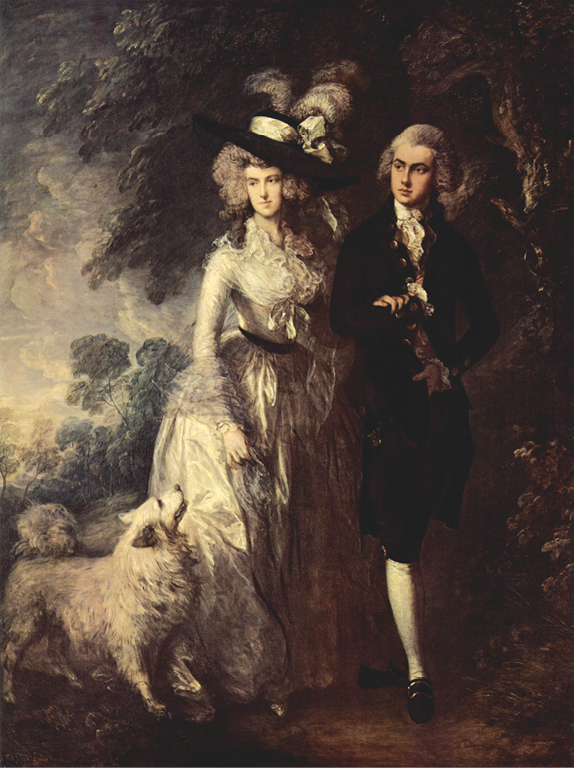
Fig.1 – An upper-class couple in eighteenth-century England.
Painting by the English artist Thomas Gainsborough (1727-1788)
The French Revolution ended these distinctions. As you know from Chapter I, members of the Jacobin clubs even called themselves the ‘sans culottes’ to distinguish themselves from the aristocracy who wore the fashionable ‘knee breeches’. Sans culottes literally meant those ‘without knee breeches’. From now on, both men and women began wearing clothing that was loose and comfortable. The colours of France – blue, white and red – became popular as they were a sign of the patriotic citizen. Other political symbols too became a part of dress: the red cap of liberty, long trousers and the revolutionary cockade pinned on to a hat. The simplicity of clothing was meant to express the idea of equality.
New words
Cockade – Cap, usually worn on one side.
Ermine – Type of fur.
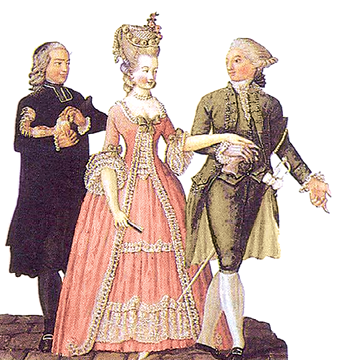
Fig.2 – An aristocratic couple on the eve of the French Revolution.
Notice the sumptuous clothing, the elaborate headgear, and the lace edgings on the dress the lady is wearing. She also has a corset inside the dress. This was meant to confine and shape her waist so that she appeared narrow waisted. The nobleman, as was the custom of the time, is wearing a long soldier’s coat, knee breeches, silk stockings and high heeled shoes. Both of them have elaborate wigs and both have their faces painted a delicate shade of pink, for the display of natural skin was considered uncultured.
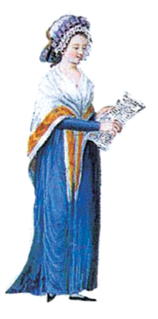
Fig.3 – Woman of the middle classes, 1791.
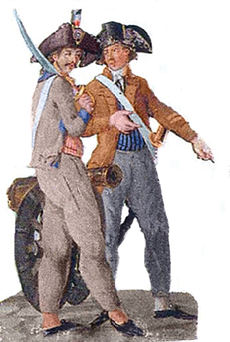
Fig.4 – Volunteers during the French Revolution.
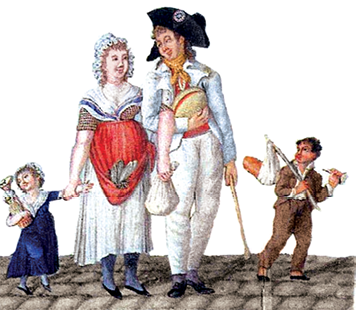
Fig.5 – A sans-culottes family, 1793.
Box 1
Not all sumptuary laws were meant to emphasise social hierarchy.
Some sumptuary laws were passed to protect home production against imports. For instance, in sixteenth-century England, velvet caps made with material imported from France and Italy were popular amongst men. England passed a law which compelled all persons over six years of age, except those of high position, to wear woollen caps made in England, on Sundays and all holy days. This law remained in effect for twenty-six years and was very useful in building up the English woollen industry.
Activity
Look at Figures 2 - 5. Write 150 words on what the differences in the pictures tell us about the society and culture in France at the time of the Revolution.
2 Clothing and Notions of Beauty
The end of sumptuary laws did not mean that everyone in European societies could now dress in the same way. The French Revolution had raised the question of equality and ended aristocratic privileges, as well as the laws that maintained those privileges. However, differences between social strata remained. Clearly, the poor could not dress like the rich, nor eat the same food. But laws no longer barred people’s right to dress in the way they wished. Differences in earning, rather than sumptuary laws, now defined what the rich and poor could wear. And different classes developed their own culture of dress. The notion of what was beautiful or ugly, proper or improper, decent or vulgar, differed.
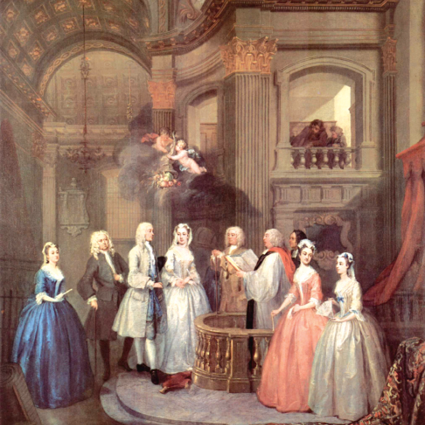
Fig.6 – Scene at an upper-class wedding by the English painter William Hogarth (1697-1764)
Styles of clothing also emphasised differences between men and women. Women in Victorian England were groomed from childhood to be docile and dutiful, submissive and obedient. The ideal woman was one who could bear pain and suffering. While men were expected to be serious, strong, independent and aggressive, women were seen as frivolous, delicate, passive and docile. Norms of clothing reflected these ideals. From childhood, girls were tightly laced up and dressed in stays. The effort was to restrict the growth of their bodies, contain them within small moulds. When slightly older, girls had to wear tight fitting corsets. Tightly laced, small-waisted women were admired as attractive, elegant and graceful. Clothing thus played a part in creating the image of frail, submissive Victorian women.
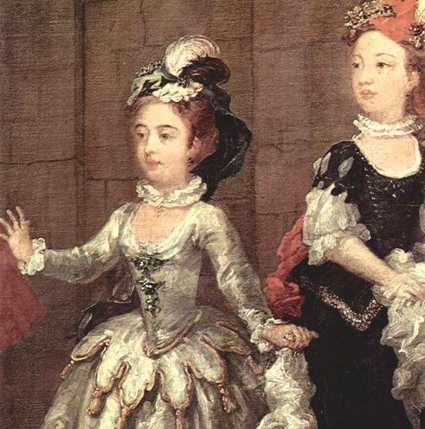
Fig.7 – A child in an aristocratic household by the English painter William Hogarth (1697-1764). Notice the tiny waist even at this age, probably held in by a corset, and the sweeping gown which would restrict her movement.
2.1 How Did Women React to These Norms?
Many women believed in the ideals of womanhood. The ideals were in the air they breathed, the literature they read, the education they had received at school and at home. From childhood they grew up to believe that having a small waist was a womanly duty. Suffering pain was essential to being a woman. To be seen as attractive, to be womanly, they had to wear the corset. The torture and pain this inflicted on the body was to be accepted as normal.
New words
Stays – Support as part of a woman’s dress to hold the body straight
Corset – A closely fitting and stiff inner bodice, worn by women to give shape and support to the figure.
Suffrage – The right to vote. The suffragettes wanted the right for women to vote.
But not everyone accepted these values. Over the nineteenth century, ideas changed. By the 1830s, women in England began agitating for democratic rights. As the suffrage movement developed, many began campaigning for dress reform. Women’s magazines described how tight dresses and corsets caused deformities and illness among young girls. Such clothing restricted body growth and hampered blood circulation. Muscles remained underdeveloped and the spines got bent. Doctors reported that many women were regularly complaining of acute weakness, felt languid, and fainted frequently. Corsets then became necessary to hold up the weakened spine.
Activity
Read Sources A and B. What do they tell you about the ideas of clothing in Victorian society? If you were the principal in Mary Somerville’s school how would you have justified the clothing practices?
Source A
Mary Somerville, one of the first woman mathematicians, describes in her memoirs the experience of her childhood days:
‘Although perfectly straight and well made, I was encased in stiff stays, with a steel busk in front, while above my frock, bands drew my shoulder back until the shoulder blades met. Then a steel rod with a semi-circle, which went under my chin, was clasped to the steel busk in my stays. In this constrained state, I and most of the younger girls had to prepare our lessons.’
From Martha Somerville, ed., Personal Recollections from Early Life to Old Age of Mary Somerville, London 1873.
Source B
Many government officials of the time were alarmed at the health implications of the prevailing styles of dressing amongst women. Consider the following attack on the corset:
‘It is evident physiologically that air is the pabulum of life, and that the effect of a tight cord round the neck and of tight lacing differ only in degrees … for the strangulations are both fatal. To wear tight stays in many cases is to wither, to waste, to die.’
The Registrar General in the Ninth Annual Report of 1857.
Source C
Do you know how the famous English poet John Keats (1795 – 1821) described his ideal woman? He said she was ‘like a milk-white lamb that bleats for man’s protection’.
In his novel Vanity Fair (1848), Thackeray described the charm of a woman character, Amelia, in these words:
‘I think it was her weakness which was her principal charm, a kind of sweet submission and softness, which seemed to appeal to each man she met, for his sympathy and protection.’
Activity
In what ways do you think these notions of weakness and dependence came to be reflected in women’s clothing?
New words
Busk – A strip of wood, whalebone or steel in front of the corset to stiffen and support it
Pabulum – Anything essential to maintain life and growth.

In America, a similar movement developed amongst the white settlers on the east coast. Traditional feminine clothes were criticised on a variety of grounds. Long skirts, it was said, swept the grounds and collected filth and dirt. This caused illness. The skirts were voluminous and difficult to handle. They hampered movement and prevented women from working and earning. Reform of the dress, it was said, would change the position of women. If clothes were comfortable and convenient, then women could work, earn their living, and become independent. In the 1870s, the National Woman Suffrage Association headed by Mrs Stanton, and the American Woman Suffrage Association dominated by Lucy Stone both campaigned for dress reform. The argument was: simplify dress, shorten skirts, and abandon corsets. On both sides of the Atlantic, there was now a movement for rational dress reform.
Box 2
The movement for Rational Dress Reform
Mrs Amelia Bloomer, an American, was the first dress reformer to launch loose tunics worn over ankle-length trousers. The trousers were known as ‘bloomers’, ‘rationals’, or ‘knickerbockers’. The Rational Dress Society was started in England in 1881, but did not achieve significant results. It was the First World War that brought about radical changes in women’s clothing.
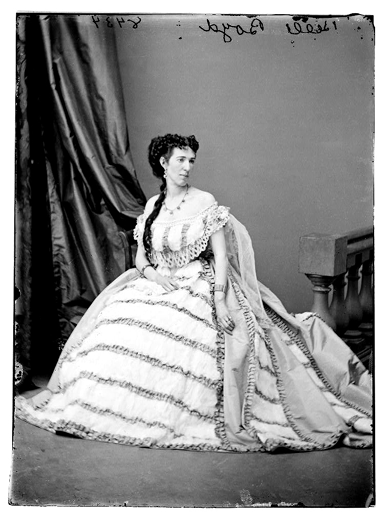
Fig.8 – A woman in nineteenth-century USA, before the dress reforms.
Notice the flowing gown sweeping the ground. Reformers reacted to this type of clothing for women.
The reformers did not immediately succeed in changing social values. They had to face ridicule and hostility. Conservatives everywhere opposed change. They lamented that women who gave up traditional norms of dressing no longer looked beautiful, and lost their femininty and grace. Faced with persistent attacks, many women reformers changed back into traditional clothes to conform to conventions.
By the end of the nineteenth century, however, change was clearly in the air. Ideals of beauty and styles of clothing were both transformed under a variety of pressures. People began accepting the ideas of reformers they had earlier ridiculed. With new times came new values.
3 New Times
What were these new values? What created the pressure for change?
Many changes were made possible in Britain due to the introduction of new materials and technologies. Other changes came about because of the two world wars and the new working conditions for women. Let us retrace our steps a few centuries to see what these changes were.
3.1 New Materials
Before the seventeenth century, most ordinary women in Britain possessed very few clothes made of flax, linen or wool, which were difficult to clean. After 1600, trade with India brought cheap, beautiful and easy-to-maintain Indian chintzes within the reach of many Europeans who could now increase the size of their wardrobes.
Then, during the Industrial Revolution, in the nineteenth century, Britain began the mass manufacture of cotton textiles which it exported to many parts of the world, including India. Cotton clothes became more accessible to a wider section of people in Europe. By the early twentieth century, artificial fibres made clothes cheaper still and easier to wash and maintain.
In the late 1870s, heavy, restrictive underclothes, which had created such a storm in the pages of women’s magazines, were gradually discarded. Clothes got lighter, shorter and simpler.
New words
Chintz – Cotton cloth printed with designs and flowers. From the Hindi word chint.

Fig.9 – Changes in clothing in the early twentieth century.
Fig.9b – Women working at a British ammunition factory during the First World War. At this time thousands of women came out to work as war production created a demand for increased labour.The need for easy movement changed clothing styles.
Fig.9a – Even for middle- and upper-class women, clothing styles changed. Skirts became shorter and frills were done away with.
Yet until 1914, clothes were ankle length, as they had been since the thirteenth century. By 1915, however, the hemline of the skirt rose dramatically to mid-calf.
Why this sudden change?
3.2 The War
Changes in women’s clothing came about as a result of the two World wars.
Many European women stopped wearing jewellery and luxurious clothes. As upper-class women mixed with other classes, social barriers were eroded and women began to dress in similar ways.
Clothes got shorter during the First World War (1914-1918) out of practical necessity. By 1917, over 700,000 women in Britain were employed in ammunition factories. They wore a working uniform of blouse and trousers with accessories such as scarves, which was later replaced by khaki overalls and caps. Bright colours faded from sight and only sober colours were worn as the war dragged on. Thus clothes became plainer and simpler. Skirts became shorter. Soon trousers became a vital part of Western women’s clothing, giving them greater freedom of movement. Most important, women took to cutting their hair short for convenience.
By the twentieth century, a plain and austere style came to reflect seriousness and professionalism. New schools for children emphasised the importance of plain dressing, and discouraged ornamentation. Gymnastics and games entered the school curriculum for women. As women took to sports, they had to wear clothes that did not hamper movement. When they went out to work they needed clothes that were comfortable and convenient.
So we see that the history of clothing is linked to the larger history of society. We saw how clothing was defined by dominant cultural attitudes and ideals of beauty, and how these notions changed over time. We saw how reformers and conservatives struggled to shape these ideals, and how changes within technology and economy, and the pressures of new times made people feel the need for change.
4 Transformations in Colonial India
What about India in this same period?
During the colonial period there were significant changes in male and female clothing in India. On the one hand this was a consequence of the influence of Western dress forms and missionary activity; on the other it was due to the effort by Indians to fashion clothing styles that embodied an indigenous tradition and culture. Cloth and clothing in fact became very important symbols of the national movement. A brief look at the nineteenth century changes will tell us a great deal about the transformations of the twentieth century.
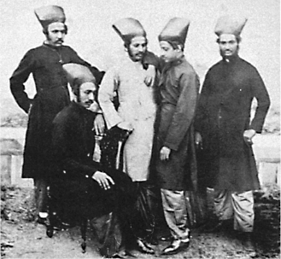
When western-style clothing came into India in the nineteenth century, Indians reacted in three different ways:
One. Many, especially men, began incorporating some elements of western-style clothing in their dress. The wealthy Parsis of western India were among the first to adapt Western-style clothing. Baggy trousers and the phenta (or hat) were added to long collarless coats, with boots and a walking stick to complete the look of the gentleman. To some, Western clothes were a sign of modernity and progress.
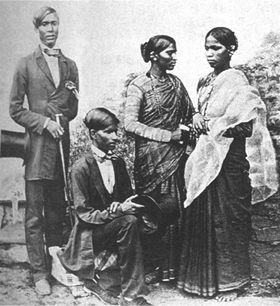
Western-style clothing was also especially attractive to some sections of society who now found it liberating. Here too, it was men rather than women who affected the new dress styles.
Two. There were others who were convinced that western culture would lead to a loss of traditional cultural identity. The use of Western-style clothes was taken as a sign of the world turning upside down. The cartoon of the Bengali Babu shown here, mocks him for wearing Western-style boots and hat and coat along with his dhoti.
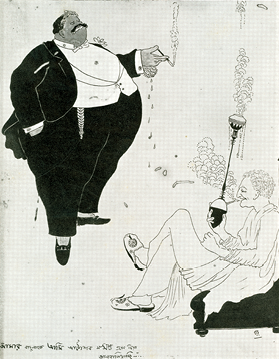
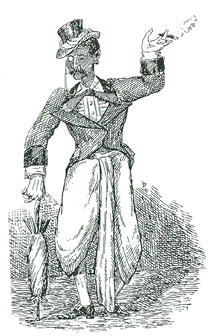
Fig.13 – Cartoon from Indian Charivari, 1873.
Three. Some men resolved this dilemma by wearing Western clothes without giving up their Indian ones. Many Bengali bureaucrats in the late nineteenth century began stocking western-style clothes for work outside the home and changed into more comfortable Indian clothes at home. Early- twentieth-century anthropologist Verrier Elwin remembered that policemen in Poona who were going off duty would take their trousers off in the street and walk home in ‘just tunic and undergarments’. This difference between outer and inner worlds is still observed by some men today.
Still others tried a slightly different solution to the same dilemma. They attempted to combine Western and Indian forms of dressing.
These changes in clothing, however, had a turbulent history.
4.1 Caste Conflict and Dress Change
Though there were no formal sumptuary laws as in Europe, India had its own strict social codes of food and dress. The caste system clearly defined what subordinate and dominant caste Hindus should wear, eat, etc., and these codes had the force of law. Changes in clothing styles that threatened these norms therefore often created violent social reactions.
In May 1822, women of the Shanar caste were attacked by Nairs in public places in the southern princely state of Travancore, for wearing a cloth across their upper bodies. Over subsequent decades, a violent conflict over dress codes ensued.
The Shanars (later known as Nadars), many of whom were considered a ‘subordinate caste’ and so were generally prohibited from using umbrellas and wearing shoes or golden ornaments. Men and women were also expected to follow the local custom of never covering their upper bodies before the dominant castes.
Under the influence of Christian missionaries, Shanar women converts began in the 1820s to wear tailored blouses and cloths to cover themselves like the dominant castes. Hindu reformers such as Ayya Vaikunder also participated in dress reform. Soon Nairs, one of the dominant castes of the region, attacked these women in public places and tore off their upper cloths. Complaints were also filed in court against this dress change, especially since Shanars were also refusing to render free labour for the dominant castes.
At first, the Government of Travancore issued a proclamation in 1829 ordering Shanar women ‘to abstain in future from covering the upper parts of the body.’ But this did not prevent Shanar Christian women, and even Shanar Hindus, from adopting the blouse and upper cloth.
The term Nadar came to be used for all Shanars by the time of the 1921 census.
The abolition of slavery in Travancore in 1855 led to even more frustration among the dominant castes who felt they were losing control. In October 1859, riots broke out as Shanar women were attacked in the marketplace and stripped of their upper cloths. Houses were looted and chapels burned. Finally, the government issued another proclamation permitting Shanar women, whether Christian or Hindu, to wear a jacket, or cover their upper bodies ‘in any manner whatever, but not like the women of high caste’.
Activity
Try and find out more about reformers of the time, such as Ayya Vaikunder, who were engaged in dress and wider social reforms.
4.2 British Rule and Dress Codes
How did the British react to Indian ways of dressing? How did Indians react to British attitudes?
In different cultures, specific items of clothing often convey contrary meanings. This frequently leads to misunderstanding and conflict. Styles of clothing in British India changed through such conflicts.
Consider the case of the turban and the hat. When European traders first began frequenting India, they were distinguished from the Indian ‘turban wearers’ as the ‘hat wearers.’ These two headgears not only looked different, they also signified different things. The turban in India was not just for protection from the heat but was a sign of respectability, and could not be removed at will. In the Western tradition, the hat had to be removed before social superiors as a sign of respect. This cultural difference created misunderstanding. The British were often offended if Indians did not take off their turban when they met colonial officials. Many Indians on the other hand wore the turban to consciously assert their regional or national identity.
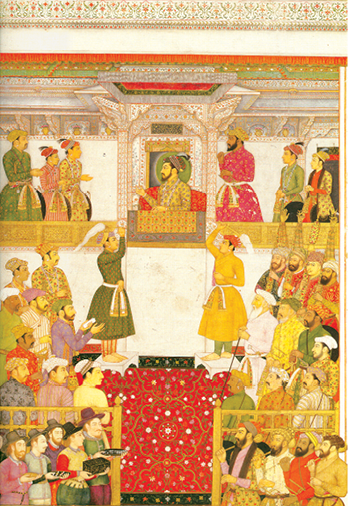
Fig.14 – Europeans bringing gifts to Shah Jehan, Agra, 1633, from the Padshahnama. Notice the European visitors’ hats at the bottom of the picture, creating a contrast with the turbans of the courtiers.
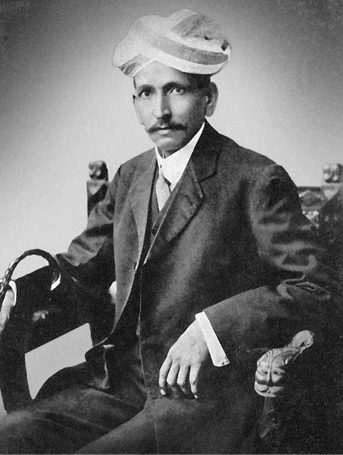
Fig.15 – Sir M. Visveswaraya. A leading engineer-technocrat and the Dewan of Mysore state from 1912 to 1918. He wore a turban with his three-piece Western style suit.
Another such conflict related to the wearing of shoes. At the beginning of the nineteenth century, it was customary for British officials to follow Indian etiquette and remove their footwear in the courts of ruling kings or chiefs. Some British officials also wore Indian clothes. But in 1830, Europeans were forbidden from wearing Indian clothes at official functions, so that the cultural identity of the white masters was not undermined.
Box 3
The turban on the head
The Mysore turban, called peta, was edged with gold lace, and adopted as part of the Durbar dress of the Mysore court in the mid-nineteenth century. By the end of the nineteenth century, a wide variety of officials, teachers and artists in Mysore began wearing the turban, sometimes with the Western suit, as a sign of belonging to the princely state. Today, the Mysore turban is used largely on ceremonial occasions and to honour visiting dignitaries.
At the same time, Indians were expected to wear Indian clothes to office and follow Indian dress codes. In 1824 - 1828, Governor-General Amherst insisted that Indians take their shoes off as a sign of respect when they appeared before him, but this was not strictly followed. By the mid-nineteenth century, when Lord Dalhousie was Governor- General, ‘shoe respect’ was made stricter, and Indians were made to take off their shoes when entering any government institution; only those who wore European clothes were exempted from this rule. Many Indian government servants were increasingly uncomfortable with these rules.
Source D
When asked to take off his shoes at the Surat Fouzdaree Adawlut at Surat in 1862, Manockjee told the judge that he was willing to take off even his turban but not his shoes. He said:
‘Taking off my pugree would have been a greater insult to myself than to the court, but I would have submitted to it, because there is nothing of conscience, or religion involved in it. I hold no respect or disrespect, embodied or disembodied in the shoes, but the putting on of our turban is the greatest of all respects that we pay. We do not have our pugrees on when at home, but when we go out to see respectable persons we are bound by social etiquette to have it on whilst we [Parsees] in our social intercourse never ever take off our shoes before any Parsee however great …’
In 1862, there was a famous case of defiance of the ‘shoe respect’ rule in a Surat courtroom. Manockjee Cowasjee Entee, an assessor in the Surat Fouzdaree Adawlut, refused to take off his shoes in the court of the sessions judge. The judge insisted that he take off his shoes as that was the Indian way of showing respect to superiors. But Manockjee remained adamant. He was barred entry into the courtroom and he sent a letter of protest to the governor of Bombay.
The British insisted that since Indians took off their shoes when they entered a sacred place or home, they should do so when they entered the courtroom. In the controversy that followed, Indians urged that taking off shoes in sacred places and at home was linked to two different questions. One: there was the problem of dirt and filth. Shoes collected the dirt on the road. This dirt could not be allowed into spaces that were clean, particularly when people in Indian homes sat on the ground. Second, leather shoes and the filth that stuck under it were seen as polluting. But public buildings like the courtroom were different from home.
Activity
Imagine yourself to be a Muslim pleader in the Allahabad high court in the late nineteenth century. What kind of clothes would you wear? Would they be very different from what you wore at home?
But it took many years before shoes were permitted into the courtroom.
5 Designing the National Dress
As nationalist feelings swept across India by the late nineteenth century, Indians began devising cultural symbols that would express the unity of the nation. Artists looked for a national style of art. Poets wrote national songs. Then a debate began over the design of the national flag. The search for a national dress was part of this move to define the cultural identity of the nation in symbolic ways.
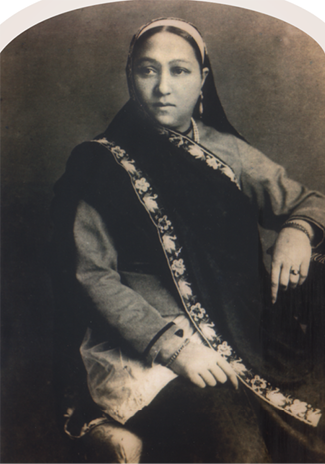
Fig. 16 – Lady Bachoobai (1890), a well-known Parsi social activist.
She is wearing a silk gara embroidered with swans and peonies, a common English flower.
(courtesy: Parsi Zoroastrian Project, New Delhi.)
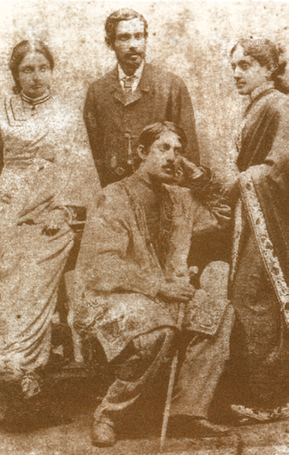
Fig.17 – Jnanadanandini Tagore (on the left) with her husband Satyendranath Tagore and other family members. She is wearing a Brahmika sari with a blouse modelled on a Western gown. (Courtesy: Rabindra Bhawan Photo Archives, Visva Bharati University, Shantiniketan)
Self-conscious experiments with dress engaged men and women of the upper classes and castes in many parts of India. The Tagore family of Bengal experimented, beginning in the 1870s, with designs for a national dress for both men and women in India. Rabindranath Tagore suggested that instead of combining Indian and European dress, India’s national dress should combine elements of Hindu and Muslim dress. Thus the chapkan (a long buttoned coat) was considered the most suitable dress for men.
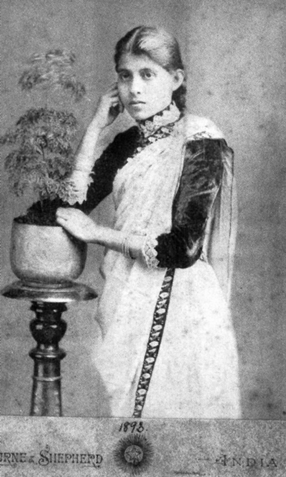
Fig.18 – Sarala daughter of RC Dutt. Note the Parsi-bordered sari with the high collared and sleeved velvet blouse showing how clothing styles flowed across regions and cultures.
There were also attempts to develop a dress style that would draw on the tradition of different regions. In the late 1870s, Jnanadanandini Devi, wife of Satyendranath Tagore, the first Indian member of the ICS, returned from Bombay to Calcutta. She adopted the Parsi style of wearing the sari pinned to the left shoulder with a brooch, and worn with a blouse and shoes. This was quickly adopted by Brahmo Samaji women and came to be known as the Brahmika sari. This style gained acceptance before long among Maharashtrian and Uttar Pradesh Brahmos, as well as non-Brahmos.
New words
Brahmo – Those belonging to the Brahmo Samaj
However, these attempts at devising a pan-Indian style did not fully succeed. Women of Gujarat, Kodagu, Kerala and Assam continue to wear different types of sari.
Source E
Some people supported the attempt to change women’s clothing, others opposed it.
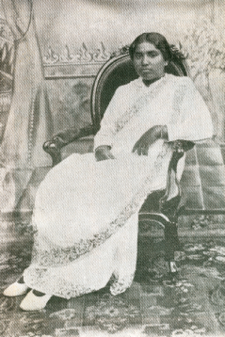
‘Any civilised nation is against the kind of clothing in use in the present time among women of our country. Indeed it is a sign of shamelessness. Educated men have been greatly agitated about it, almost everyone wishes for another kind of civilised clothing … there is a custom here of women wearing fine and transparent clothing which reveals the whole body. Such shameless attire in no way allows one to frequent civilised company … such clothes can stand in the way of our moral improvement.’
Soudamini Khastagiri, Striloker Paricchad (1872)
Fig.19 – Maharani of Travancore (1930).
Note the Western shoes and the modest long- sleeved blouse. This style had become common among the upper classes by the early twentieth century.
Source F
C. Kesavan’s autobiography Jeevita Samaram recalls his mother-in-law’s first encounter with a blouse gifted by her sister-in-law in the late nineteenth century:
‘It looked good, but I felt ticklish wearing it. I took it off, folded it carefully and brimming with enthusiasm, showed it to my mother. She gave me a stern look and said “Where are you going to gallivant in this? Fold it and keep it in the box.” … I was scared of my mother. She could kill me. At night I wore the blouse and showed it to my husband. He said it looked good … [the next morning] I came out wearing the blouse … I didn’t notice my mother coming. Suddenly I heard her break a piece from a coconut branch. When I turned round, she was behind me fierce and furious … she said “Take it off … you want to walk around in shirts like Muslim women?”’
Activity
These two quotations (Sources E and F), from about the same period are from two different regions of India, Kerala and Bengal. What do they tell you about the very different notions of shame regarding women’s attire?
5.1 The Swadeshi Movement
You have read about the Swadeshi movement in Bengal in the first decade of the twentieth century. If you reflect back on the movement you will realize that it was centrally linked to the politics of clothing.
What was this politics?
You know that the British first came to trade in Indian textiles that were in great demand all over the world. India accounted for one- fourth of the world’s manufactured goods in the seventeenth century. There were a million weavers in Bengal alone in the middle of the eighteenth century. However, the Industrial Revolution in Britain, which mechanised spinning and weaving and greatly increased the demand for raw materials such as cotton and indigo, changed India’s status in the world economy.
Political control of India helped the British in two ways: Indian peasants could be forced to grow crops such as indigo, and cheap British manufacture easily replaced coarser Indian one. Large numbers of Indian weavers and spinners were left without work, and important textile weaving centres such as Murshidabad, Machilipatnam and Surat declined as demand fell.
Yet by the middle of the twentieth century, large numbers of people began boycotting British or mill-made cloth and adopting khadi, even though it was coarser, more expensive and difficult to obtain. How did this change come about?
In 1905, Lord Curzon decided to partition Bengal to control the growing opposition to British rule. The Swadeshi movement developed in reaction to this measure. People were urged to boycott British goods of all kinds and start their own industries for the manufacture of goods such as matchboxes and cigarettes. Mass protests followed, with people vowing to cleanse themselves of colonial rule. The use of khadi was made a patriotic duty. Women were urged to throw away their silks and glass bangles and wear simple shell bangles. Rough homespun was glorified in songs and poems to popularise it.
Activity
If you were a poor peasant would you have willingly taken to giving up mill-made cloth?
The change of dress appealed largely to the upper castes and classes rather than to those who had to make do with less and could not afford the new products. After 15 years, many among the upper classes also returned to wearing European dress.
Though many people rallied to the cause of nationalism at this time, it was almost impossible to compete with cheap British goods that had flooded the market.
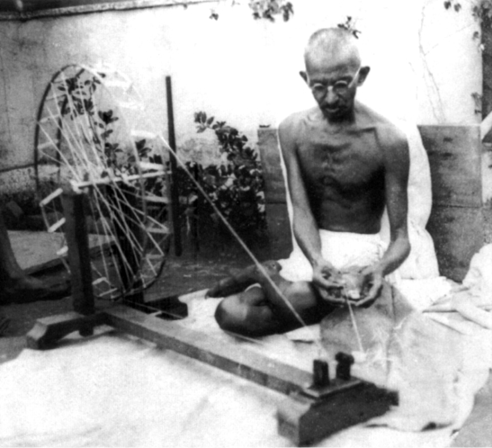
Fig.20 – The familiar image of Mahatma Gandhi, bare chested and at his spinning wheel.
Despite its limitations, the experiment with Swadeshi gave Mahatma Gandhi important ideas about using cloth as a symbolic weapon against British rule.
5.2 Mahatma Gandhi’s Experiments with Clothing
The most familiar image of Mahatma Gandhi is of him seated, bare chested and in a short dhoti, at the spinning wheel. He made spinning on the charkha and the daily use of khadi, or coarse cloth made from homespun yarn, very powerful symbols. These were not only symbols of self-reliance but also of resistance to the use of British mill-made cloth.
Mahatma Gandhi’s experiments with clothing sum up the changing attitude to dress in the Indian subcontinent. As a boy from a Gujarati Bania family, he usually wore a shirt with a dhoti or pyjama, and sometimes a coat. When he went to London to study law as a boy of 19 in 1888, he cut off the tuft on his head and dressed in a Western suit so that he would not be laughed at. On his return, he continued to wear Western suits, topped with a turban. As a lawyer in Johannesburg, South Africa in the 1890s, he still wore Western clothes.
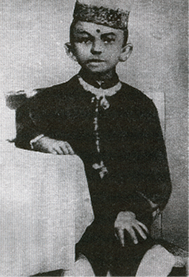
Fig.21 – Mahatma Gandhi in his earliest known picture, aged 7.
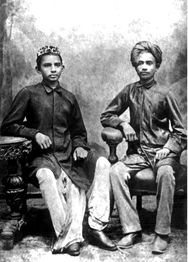
Fig.22 – Mahatma Gandhi at age 14, with a friend.
Soon he decided that dressing ‘unsuitably’ was a more powerful political statement. In Durban in 1913, Gandhi first appeared in a lungi and kurta with his head shaved as a sign of mourning to protest against the shooting of Indian coal miners.
On his return to India in 1915, he decided to dress like a Kathiawadi peasant. Only in 1921 did he adopt the short dhoti, the form of dress he wore until his death. On 22 September 1921, a year after launching the non-cooperation movement, which sought swaraj in one year, he announced:
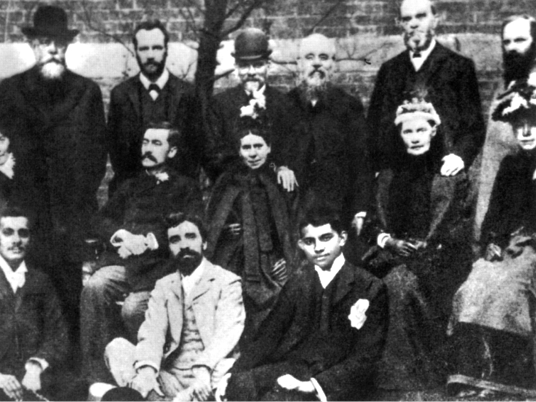
Fig.23 – Mahatma Gandhi (seated front right) London, 1890, at the age of 21. Note the typical Western three-piece suit.
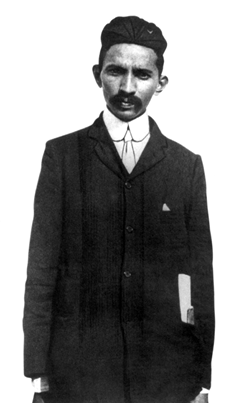
Fig.24 – In Johannesburg in 1900, still in Western dress, including tie.
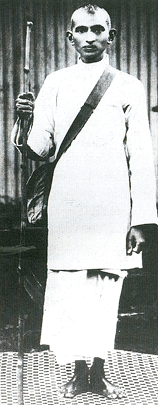
Fig. 25 – In 1913 in South Africa, dressed for Satyagraha
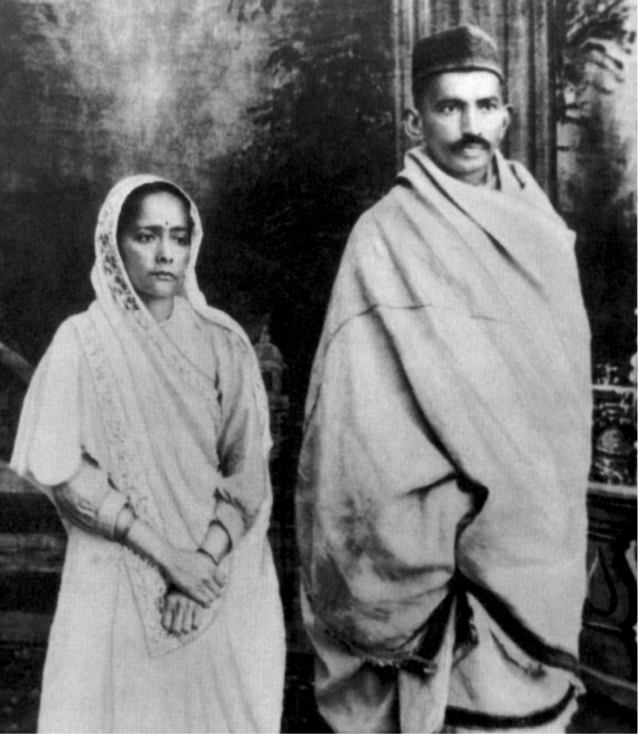
Fig.26 – Mahatma Gandhi with Kasturba, shortly after his return from South Africa. Dressed simply, he later confessed to feeling awkward amongst the Westernised Bombay elite. He said that he was more at home among the labourers in South Africa.
‘I propose to discard at least up to 31st of October my topi and vest and to content myself with a loincloth, and a chaddar whenever necessary for protection of my body. I adopt the change because I have always hesitated to advise anything I may not be prepared to follow …’
At this time, he did not want to use this dress all his life and only wanted to ‘experiment for a month or two’. But soon he saw this as his duty to the poor, and he never wore any other dress. He consciously rejected the well-known clothes of the Indian ascetic and adopted the dress of the poorest Indian. Khadi, white and coarse, was to him a sign of purity, of simplicity, and of poverty. Wearing it became also a symbol of nationalism, a rejection of Western mill- made cloth.
He wore the short dhoti without a shirt when he went to England for the Round Table Conference in 1931. He refused to compromise and wore it even before King George V at Buckingham Palace. When he was asked by journalists whether he was wearing enough clothes to go before the King, he joked that that ‘the King had enough on for both of us’!
5.3 Not All could Wear Khadi
Mahatma Gandhi’s dream was to clothe the whole nation in khadi. He felt khadi would be a means of erasing difference between religions, classes, etc. But was it easy for others to follow in his footsteps? Was such a unity possible? Not many could take to the single peasant loincloth as he had. Nor did all want to. Here are some examples of other responses to Mahatma Gandhi’s call:
· Nationalists such as Motilal Nehru, a successful barrister from Allahabad, gave up his expensive Western-style suits and adopted the Indian dhoti and kurta. But these were not made of coarse cloth.
· Those who had been deprived by caste norms for centuries were attracted to Western dress styles. Therefore, unlike Mahatma Gandhi, other nationalists such as Babasaheb Ambedkar never gave up the Western-style suit. Many Dalits began in the early 1910s to wear three-piece suits, and shoes and socks on all public occasions, as a political statement of self-respect.
· A woman who wrote to Mahatma Gandhi from Maharashtra in 1928 said, ‘A year ago, I heard you speaking on the extreme necessity of every one of us wearing khadi and thereupon decided to adopt it. But we are poor people, My husband says khadi is costly. Belonging as I do to Maharashtra, I wear a sari nine yards long … (and) the elders will not hear of a reduction (to six yards).’
· Other women, like Sarojini Naidu and Kamala Nehru, wore coloured saris with designs, instead of coarse, white homespun.
Activity
Can you think of other reasons why the use of khadi could not spread among some classes, castes and regions of India?
Conclusion
Changes in styles of clothing are thus linked up with shifts in cultural tastes and notions of beauty, with changes within the economy and society, and with issues of social and political conflict. So when we see clothing styles alter we need to ask: why do these changes take place? What do they tell us about society and its history? What can they tell us about changes in tastes and technologies, markets and industries?
Box 4
The Gandhi cap
Some time after his return to India from South Africa in 1915, Mahatma Gandhi transformed the Kashmiri cap that he sometimes used into a cheap white cotton khadi cap. For two years from 1919, he himself wore the cap, and then gave it up, but by this time it had become part of the nationalist uniform and even a symbol of defiance. For example, the Gwalior state tried to prohibit its use in 1921 during the non co-operation movement. During the Khilafat movement the cap was worn by large numbers of Hindus and Muslims. A group of Santhals who attacked the police in 1922 in Bengal demanding the release of Santhal prisoners believed that the Gandhi cap would protect them from bullets: three of them died as a result.
Large numbers of nationalists defiantly wore the Gandhi cap and were even beaten or arrested for doing so. With the rise of the Khilafat movement in the post-First World War years, the fez, a tasseled Turkish cap, became a sign of anti-colonialism in India. Though many Hindus – as in Hyderabad for instance – also wore the fez, it soon became identified solely with Muslims.

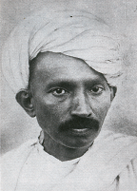
Fig.27 – 1915. Mahatma Gandhi with a turban.
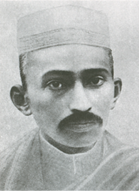
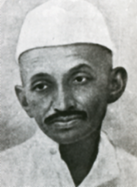
Fig.29 – 1920. Wearing the Gandhi cap.
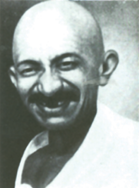
Fig.30 – 1921. After shaving his head.
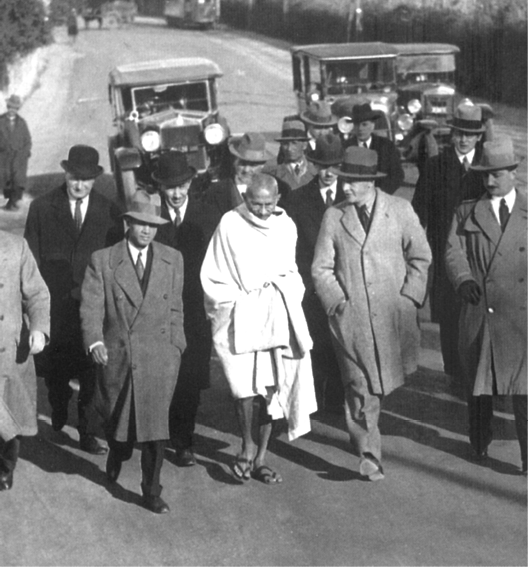
Fig.31 – On his visit to Europe in 1931. By now his clothes had become a powerful political statement against Western cultural domination.
Activities
1. Imagine you are the 14-year-old child of a trader. Write a paragraph on what you feel about the sumptuary laws in France.
2. Can you think of any expectations of proper and improper dress which exist today? Give examples of two forms of clothing which would be considered disrespectful in certain places but acceptable in others.
Questions
1. Explain the reasons for the changes in clothing patterns and materials in the eighteenth century.
2. What were the sumptuary laws in France?
3. Give any two examples of the ways in which European dress codes were different from Indian dress codes.
4. In 1805, a British official, Benjamin Heyne, listed the manufactures of Bangalore which included the following:
Women’s cloth of different musters and names
▸ Coarse chintz
▸ Muslins
▸ Silk cloths
Of this list, which kind of cloth would have definitely fallen out of use in the early 1900s and why?
5. Suggest reasons why women in nineteenth century India were obliged to continue wearing traditional Indian dress even when men switched over to the more convenient Western clothing. What does this show about the position of women in society?
6. Winston Churchill described Mahatma Gandhi as a ‘seditious Middle Temple Lawyer’ now ‘posing as a half naked fakir’.
What provoked such a comment and what does it tell you about the symbolic strength of Mahatma Gandhi’s dress?
7. Why did Mahatma Gandhi’s dream of clothing the nation in khadi appeal only to some sections of Indians?
Credits
